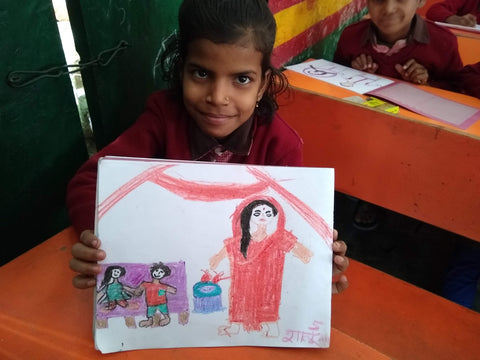Colourful Logics of a Child

Child Art is a result of the observations, emotions, experiences and imagination of a child, which later helps her develop into a creative person. And while our children put so much effort into their drawing, we have a habit of distinguishing them as good or bad without even trying to understand them. Many emotions can be revealed in a child’s drawing and we need to look closely to identify those emotions. However, before getting too much into what it might mean, always allow the child to explain her work. This would help you interpret the drawing better and hence have a better understanding of your child’s feelings. Although there are some points picked out of child psychology texts, that might display what a child is really feeling.
Proportions of figures in child art are purely psychological. When a child draws someone whom she respects or knows them to be an important or powerful person, that figure is proportionally larger. Larger figures also denote dominance or fear. 
This interpretation becomes more clear with the colour preferences of a child. If a child uses dark colours, she is probably sad or unaware of her feelings. Children also express their thoughts about other people in their drawings. If they like someone, their drawings are coloured in warm and bright colours, while if someone is angry or strict with them, their drawings are usually coloured in dark colours.
If the drawing is well proportionate and fills the complete page, the child is feeling well-balanced and secure. In contrast, small figures in the middle of the page or by the edge denote inadequacy and insecurity. Children who are hesitant in talking and opening up can be read through their drawings. Small figures with lots of details in the drawing might suggest that the child feels the need to work hard on everything.
Decoding a child art is easier if we encourage the child to talk. It is essential for the child to feel the freedom to express her feelings through drawing without fear of judgement of her skills. Parents and teachers need to encourage and appreciate their artworks, to help them grow into a creative and confident person. All that needs to be done is to provide the child with basic art supplies, crayons and paper, and leave them to explore their minds. Remember that when the child knows that you trust her, she can do wonders.
References:
* https://www.theatlantic.com/education/archive/2017/10/the-hidden-meaning-of-kids-shapes-and-scribbles/543873/
* https://novakdjokovicfoundation.org/learn-to-decode-childrens-drawings/#:~:text=But%20sometimes%2C%20interpreting%20children's%20drawings,the%20drawing%20means%20to%20them
